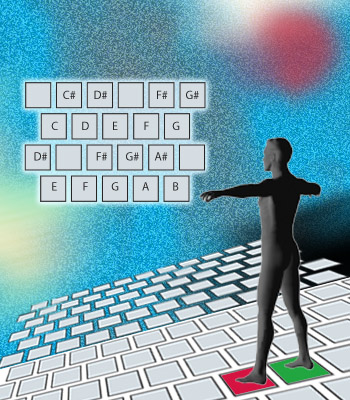|
| >> |
overview
 I became involved with data collection while working in the corporate
world. I'm very interested in the different ways that data is being used.
For instance, when you use your club card at the grocery store, they know
who you are, what types of food you buy, and if you buy a lot of coke,
your receipt might contain a coupon for a bottle of coke. I would like
to use a different set of collected data to create an audio/visual landscape
called 'Interactive Learning & Performance Garden', that is based
on participants stepping and standing on squares for various lengths of
time. Users will be able to dance on the tiles while creating a musical
composition, and automatically create a visual art response based on their
movements on the tiles.
I became involved with data collection while working in the corporate
world. I'm very interested in the different ways that data is being used.
For instance, when you use your club card at the grocery store, they know
who you are, what types of food you buy, and if you buy a lot of coke,
your receipt might contain a coupon for a bottle of coke. I would like
to use a different set of collected data to create an audio/visual landscape
called 'Interactive Learning & Performance Garden', that is based
on participants stepping and standing on squares for various lengths of
time. Users will be able to dance on the tiles while creating a musical
composition, and automatically create a visual art response based on their
movements on the tiles.
The main interactive component of this piece will be approximately 70 velocity sensitive squares that are embedded into the floor(along with the regular floor tiles) of a piazza. Each square will be assigned a semitone sound and the full range of squares will cover 6+ octaves. Each time a square is stepped on it will light up in an assigned color, and depending on the amount of pressure or velocity of the step the color will range from light to vibrant. With each step, data is collected for each square, the amount of velocity applied, on/off events, and the length of the sustain.
In real time, based on the data being collected, a visual response is being created on a large video screen. Colors are assigned to each piece of data and displayed in linear form across the screen. As long as there is activity on the piazza floor the visual art piece will continue to grow. If there is no activity for a set amount of time, the recorded data (for that particular day) will playback in reverse, When someone reenters the piazza and steps on one of the interactive squares the screen will be wiped clean and start over.
Other Possibilities:
Visual:
There are many possibilities for the visual response, since we can do anything with the collected data. Another idea might include color sampling, which will be based on snapshots of pedestrians that are taken throughout the day by a fixed camera. These samples can be used in place of the colors that are generated by the stepping of various squares.Sound:
A microphone or microphones can be setup in various locations near the garden to capture sounds throughout a day. These sounds can be synthesized through some algorithm and then be used as the sound source for the synthesizer.More speakers and channels can be added to create new spatial effects based on many different patterns or locations of participants in the garden.
As A Learning Tool:
Since the garden records data and can playback performances, participants can program certain tiles in a form of a dance, then teach students by informing them to step on the tiles that light up - similar to 'Simon Says'.
Main components:
- Outdoor installation and performance of audio and visual interaction
- Controller - Color coded squares embedded into the plaza that generate different tones
- Data collection – based on squares pressed (on/off), velocity of stepping on the tile, duration of sustain, note, date/time
- Polyphonic synthesizer
- Allows multiple users
- Record / Playback
- Video screen used to display the data collection as an ever changing work of art
| >> |